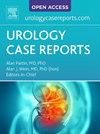Treatment of a high-volume retroperitoneal lymphocele with obstructive hydronephrosis following lymph node dissection via combined intra-lymphocele retrograde lymphangiography with glue embolization and sclerotherapy
IF 0.5
Q4 UROLOGY & NEPHROLOGY
引用次数: 0
Abstract
Management of symptomatic lymphoceles typically involves sclerotherapy and lymphangiography with embolization. When many afferent lymphatic channels are supplying a large-volume lymphocele, sclerotherapy is associated with high recurrence rate. This case presents a patient who underwent retroperitoneal lymph node dissection and developed a high-volume lymphocele that was compressing the ipsilateral ureter, causing hydronephrosis. He was treated with retrograde lymphangiography, whereby contrast dye was injected through the existing lymphocele drain and afferent lymphatics were visualized upon contrast reflux. These afferent channels were embolized and the lymphocele cavity was sclerosed, leading to reduction in lymphocele output, drain removal, and normalization of kidney function.
淋巴鞘内逆行淋巴管造影联合胶栓和硬化疗法治疗淋巴结清扫后大容量腹膜后淋巴囊肿伴阻塞性肾积水。
症状性淋巴囊肿的治疗通常包括硬化治疗和栓塞性淋巴管造影。当许多传入淋巴通道供应大容量淋巴囊肿时,硬化治疗与高复发率有关。本病例是一例接受腹膜后淋巴结清扫术的患者,出现压迫同侧输尿管的大容量淋巴囊肿,导致肾积水。他接受逆行淋巴管造影治疗,通过现有的淋巴细胞引流管注入造影剂,造影剂回流后可见传入淋巴管。这些传入通道被栓塞,淋巴囊肿腔被硬化,导致淋巴囊肿输出减少,引流物清除,肾功能正常化。
本文章由计算机程序翻译,如有差异,请以英文原文为准。
求助全文
约1分钟内获得全文
求助全文

 求助内容:
求助内容: 应助结果提醒方式:
应助结果提醒方式:


